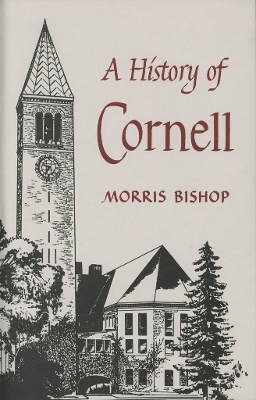
A History of Cornell
Cornell University Press (Verlag)
978-0-8014-0036-0 (ISBN)
- Lieferbar (Termin unbekannt)
- Versandkostenfrei
- Auch auf Rechnung
- Artikel merken
Cornell University is fortunate to have as its historian a man of Morris Bishop's talents and devotion. As an accurate record and a work of art possessing form and personality, his book at once conveys the unique character of the early university—reflected in its vigorous founder, its first scholarly president, a brilliant and eccentric faculty, the hardy student body, and, sometimes unfortunately, its early architecture—and establishes Cornell's wider significance as a case history in the development of higher education. Cornell began in rebellion against the obscurantism of college education a century ago. Its record, claims the author, makes a social and cultural history of modern America. This story will undoubtedly entrance Cornellians; it will also charm a wider public.
Dr. Allan Nevins, historian, wrote: "I anticipated that this book would meet the sternest tests of scholarship, insight, and literary finish. I find that it not only does this, but that it has other high merits. It shows grasp of ideas and forces. It is graphic in its presentation of character and idiosyncrasy. It lights up its story by a delightful play of humor, felicitously expressed. Its emphasis on fundamentals, without pomposity or platitude, is refreshing. Perhaps most important of all, it achieves one goal that in the history of a living university is both extremely difficult and extremely valuable: it recreates the changing atmosphere of time and place. It is written, very plainly, by a man who has known and loved Cornell and Ithaca for a long time, who has steeped himself in the traditions and spirit of the institution, and who possesses the enthusiasm and skill to convey his understanding of these intangibles to the reader."
The distinct personalities of Ezra Cornell and first president Andrew Dickson White dominate the early chapters. For a vignette of the founder, see Bishop's description of "his" first buildings (Cascadilla, Morrill, McGraw, White, Sibley): "At best," he writes, "they embody the character of Ezra Cornell, grim, gray, sturdy, and economical." To the English historian, James Anthony Froude, Mr. Cornell was "the most surprising and venerable object I have seen in America." The first faculty, chosen by President White, reflected his character: "his idealism, his faith in social emancipation by education, his dislike of dogmatism, confinement, and inherited orthodoxy"; while the "romantic upstate gothic" architecture of such buildings as the President's house (now Andrew D. White Center for the Humanities), Sage Chapel, and Franklin Hall may be said to "portray the taste and Soul of Andrew Dickson White."
Other memorable characters are Louis Fuertes, the beloved naturalist; his student, Hugh Troy, who once borrowed Fuertes' rhinoceros-foot wastebasket for illicit if hilarious purposes; the more noteworthy and the more eccentric among the faculty of succeeding presidential eras; and of course Napoleon, the campus dog, whose talent for hailing streetcars brought him home safely—and alone—from the Penn game. The humor in A History of Cornell is at times kindly, at times caustic, and always illuminating.
The late Morris Bishop was Kappa Alpha Professor of Romance Literature and University Historian at Cornell University. He was the author of A History of Cornell, also from Cornell University Press. The late Morris Bishop was Kappa Alpha Professor of Romance Literature and University Historian at Cornell University. He was the author of A History of Cornell, also from Cornell University Press.
1. Prelude
2. Ezra Cornell
3. Andrew D. White
4. The Conception of a University
5. The Making of a University
6. The Early Years: A Perambulation of the Campus
7. The Early Years: The Men
8. The Early Years: The Boys
9. The Early Years: The Girls
10. The Early Years: Instruction and Education
11. The Early Years: Triumphs and Trials
12. The Doubtful Years, 1876–1881
13. The Great Will Case
14. Reconstruction, 1881–1885
15. President Adams, 1885–1892
16. Cornell under President Adams: The Business of Education
17. Cornell under President Adams: The Teachers and the Taught
18. The Nineties: President Schurman and the State of New York
19. The Nineties: Cornell Medical College
20. The Nineties: The Educational Machine
21. The Nineties: Cornellians and Their Home
22. The New Century: Cornell's Soul and Body
23. The New Century: The Rise of Agriculture
24. The New Century: Cornell Medical College
25. The New Century: The Other Colleges
26. The New Century: Prewar Cornellians
27. The First War
28. Interregnum I, 1920–1921
29. President Farrand: The Campus
30. President Farrand’s Regime: Organization and Administration
31. Cornell under President Farrand: Education
32. Cornell under President Farrand: Campus Life
33. Cornell under President Farrand: Athletics
34. The Medical College: Retirement of President Farrand
35. Cornell under President Day: Prewar
36. Cornell under President Day: War
37. Cornell under President Day: Postwar Administration
38. Cornell under President Day: Postwar Education and Research
39. Cornell under President Day: The Postwar Student
40. Interregnum II, 1949–1951
41. Cornell under President Malott
42. PostludeExcursus I: President White in His Library
Excursus II: Boring on Titchener
Excursus III: Cornell AuthorsAcknowledgments and Bibliographical Note
Index
| Erscheint lt. Verlag | 31.10.1962 |
|---|---|
| Illustrationen | Alison Mason Kingsbury |
| Zusatzinfo | 14 Line drawings, black and white |
| Verlagsort | Ithaca |
| Sprache | englisch |
| Maße | 155 x 235 mm |
| Gewicht | 1361 g |
| Themenwelt | Geschichte ► Teilgebiete der Geschichte ► Kulturgeschichte |
| ISBN-10 | 0-8014-0036-8 / 0801400368 |
| ISBN-13 | 978-0-8014-0036-0 / 9780801400360 |
| Zustand | Neuware |
| Haben Sie eine Frage zum Produkt? |
aus dem Bereich


